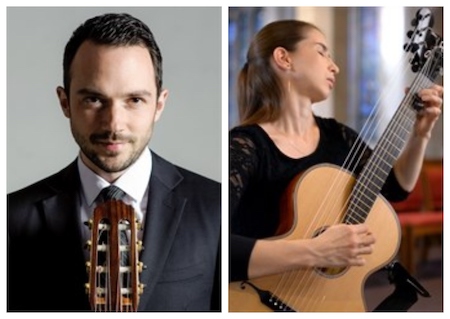by Jarrett Hoffman

“There used to be so many instances in arranging music when I said to myself, I wish I had some extra strings,” guitarist Drew Henderson said during a recent call from Toronto. So when an opportunity presented itself to purchase an eight-string guitar for a good price, he went for it. “And I haven’t looked back.”
Henderson will share the bill with Petra Polácková during a free, pre-recorded concert on Friday, June 4 as part of the Cleveland International Classical Guitar Festival. The Canadian guitarist will make use of the eight-string instrument for his own arrangement of the Prelude, Sarabande, and Boureés from J.S. Bach’s Fourth Cello Suite. His program also includes Joaquín Turina’s Sonata and Johann Kaspar Mertz’s arrangement of Schubert’s Lob der Tränen.
Henderson’s portion of the evening airs here at 7:30 pm, while Polácková will take the reins at 8:15 pm here with a program of music by John Dowland, Miguel Llobet, and Mertz. Admission is free, and donations can be placed here to support the artists.
Getting back to Henderson and the eight-string instrument, simply adding two strings doesn’t tell the whole story. “I’ve dabbled with a lower and a higher string,” Henderson said. “But guitar is all about the tone, and that high string in my opinion is a bit too shrill to be a first melodic string. So I opted for two bass strings, because they just sound cooler.”
His love of arrangements can be traced back to early in his classical guitar studies, particularly to an album his brother brought home one day: Eliot Fisk’s Paganini 24 Caprices, containing those famous works adapted from the violin. “At the time I was a total metalhead guitarist, and I heard that and thought, this is amazing,” Henderson said. “That’s probably what sparked my first interests in it, but also my dad liked a lot of different types of music, and I always have too. If it fits on the guitar, I won’t be scared to go for it.”
Housing many of Henderson’s arrangements and performances is his popular YouTube Channel. I was curious to ask the guitarist about the experience of having such a large following online, and as a result hearing feedback from many, many voices.
“It was a little strange at first, but I guess you become desensitized to it,” he said. “I just kind of do what I want to do. I’ll see some nice comments, and it makes me feel good, and once in a while I get a bad comment. You get a lot of weird comments, too, actually. When a channel gets really popular, people come out of the woodwork.”
Beyond performing, recording, and teaching, Henderson’s career also involves music production, encompassing both sound engineering and videography. Even at the start of the pandemic, when opportunities for many musicians vanished, he remained busy in those areas.
“I was a little bit backed up with two full albums to edit and master, and a bunch of video projects,” he said. When the schedule eventually slowed down, he took advantage of the time off by putting together a home studio, where he filmed his video for the Festival. “I’m really happy with the studio,” he said. “I’m going to expand on my YouTube Channel by making some lesson videos and things like that.”
Speaking of the Festival, what was it like to put together his video? “It’s very intense to record music, so I did that over a couple days. It’s got to be so perfect, so you end up doing lots of takes, and there are plenty of things to check in between.”
The day after, he wrote out scripts to prepare for spoken segments, which will include details about the Bach adaptation and choosing the eight-string guitar, as well as the history behind Schubert arrangements, which date back to Franz Liszt. And taking advantage of the close-up, visual side of online concerts, he’ll share some scores with the audience — a nice cherry on top.
Published on ClevelandClassical.com June 1, 2021.
Click here for a printable copy of this article



